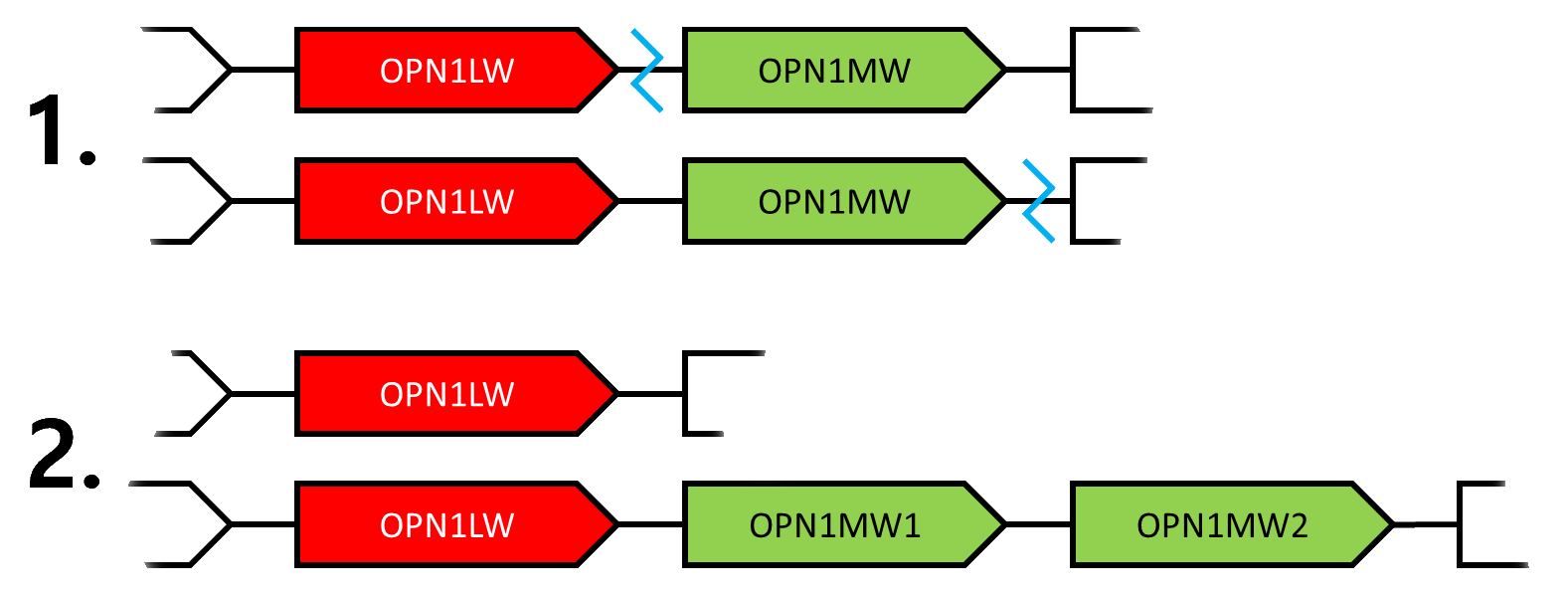OPN1MW2 on:
[Wikipedia]
[Google]
[Amazon]
OPN1MW2 is a duplication of the
 OPN1MW2 is a duplication of the
OPN1MW2 is a duplication of the
OPN1MW
Green-sensitive opsin is a protein that in humans is encoded by the ''OPN1MW'' gene.
OPN1MW2 is a similar opsin.
See also
* Opsin
Animal opsins are G-protein-coupled receptors and a group of proteins made light-sensitive via a chromophore, ...
gene, which encodes the medium wavelength sensitive (MWS) photopsin
Vertebrate visual opsins are a subclass of ciliary opsins and mediate vision in vertebrates. They include the opsins in human rod and cone cells. They are often abbreviated to ''opsin'', as they were the first opsins discovered and are still t ...
. The gene duplication is present in about 50% of X-chromosomes, so is present in 50% of males and at least once 75% of females. It caused by the same mechanism that causes congenital red-green color blindness, the most common form of color blindness
Color blindness or color vision deficiency (CVD) is the decreased ability to color vision, see color or differences in color. It can impair tasks such as selecting ripe fruit, choosing clothing, and reading traffic lights. Color blindness may ...
.
Gene Duplication
 OPN1MW2 is a duplication of the
OPN1MW2 is a duplication of the OPN1MW
Green-sensitive opsin is a protein that in humans is encoded by the ''OPN1MW'' gene.
OPN1MW2 is a similar opsin.
See also
* Opsin
Animal opsins are G-protein-coupled receptors and a group of proteins made light-sensitive via a chromophore, ...
gene arising from unequal homologous recombination
Homologous recombination is a type of genetic recombination in which genetic information is exchanged between two similar or identical molecules of double-stranded or single-stranded nucleic acids (usually DNA as in cellular organisms but may ...
. During this process, one of the X-chromosomes "donates" its OPN1MW gene to the other chromosome, resulting in:
* One chromosome without a OPN1MW gene, which carries protanopia
Color blindness or color vision deficiency (CVD) is the decreased ability to see color or differences in color. It can impair tasks such as selecting ripe fruit, choosing clothing, and reading traffic lights. Color blindness may make some aca ...
* One chromosome with two OPN1MW genes, although only the first gene in the chain (OPN1MW1) will generally be expressed and the second gene OPN1MW2 will remain unexpressed.
The only difference between the two genes is their position in the gene cluster
A gene family is a set of homologous genes within one organism. A gene cluster is a group of two or more genes found within an organism's DNA that encode similar polypeptides, or proteins, which collectively share a generalized function and are ...
. They are equal in that they have the same chances of encoding a certain OPN1MW allele. However, in a given X-chromosome, they may encode different alleles.
Tetrachromacy
There are several theories fortetrachromacy
Tetrachromacy (from Greek ''tetra'', meaning "four" and ''chromo'', meaning "color") is the condition of possessing four independent channels for conveying color information, or possessing four types of cone cell in the eye. Organisms with te ...
in humans, but the most popular theory is related to females carriers of color blindness
Color blindness or color vision deficiency (CVD) is the decreased ability to color vision, see color or differences in color. It can impair tasks such as selecting ripe fruit, choosing clothing, and reading traffic lights. Color blindness may ...
. Carriers will have one opsin gene (OPN1MW
Green-sensitive opsin is a protein that in humans is encoded by the ''OPN1MW'' gene.
OPN1MW2 is a similar opsin.
See also
* Opsin
Animal opsins are G-protein-coupled receptors and a group of proteins made light-sensitive via a chromophore, ...
or OPN1LW
OPN1LW is a gene on the X chromosome that encodes for long wave sensitive (LWS) opsin, or red cone photopigment. It is responsible for perception of visible light in the yellow-green range on the visible spectrum (around 500-570nm). The gene con ...
) with differing alleles thereof on each chromosome, such that the alleles encode proteins with different spectral sensitivities. Both of these alleles are expressed due to x-inactivation
X-inactivation (also called Lyonization, after English geneticist Mary Lyon) is a process by which one of the copies of the X chromosome is inactivated in therian female mammals. The inactive X chromosome is silenced by being packaged into a ...
, so a carrier will have 4 distinct cones
A cone is a three-dimensional geometric shape that tapers smoothly from a flat base (frequently, though not necessarily, circular) to a point called the apex or vertex.
A cone is formed by a set of line segments, half-lines, or lines conn ...
with different spectral sensitivities, which is one prerequisite of tetrachromacy.
This theory cannot be extended to females who have identical alleles in their OPN1MW1 genes, but a different allele in their OPN1MW2 gene, since the latter is never expressed, and if it were co-expressed with OPN1MW1, the two alleles would not be isolated in different photoreceptors. Therefore the OPN1MW2 gene is not considered a likely candidate mechanism for tetrachromacy.
References
{{G protein-coupled receptors Color vision